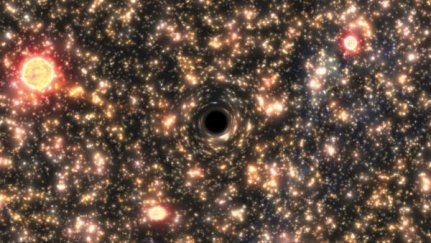At first glance across the Universe, the masses of black holes in small galaxies seem to be pretty random compared to those in larger galaxies.
But now Swinburne University of Technology scientists have shown that it's possible to predict the masses of even the most random black holes.
Generally the theory goes that in large galaxies, the central black hole is closely related to the mass of the spherical distribution of stars at the centre of the galaxy, known as the galaxy's 'bulge'. Their ratio of mass is around half a percent.
But galaxies with small bulges seem to contain black holes that are much smaller than this 0.5 percent ratio, and are thought to be unrelated to their galaxy's bulge-size.
This was the case in our own Milky Way galaxy, where the mass of our black hole seems to be ten times too low compared to some of its counterparts.
But in previous work, a Swinburne astronomer, Alister Graham, identified a relationship between black holes and galaxies with small bulges - it wasn't random at all, instead it followed an astronomical rule.
"The formula is quadratic, in that the black hole mass quadruples every time the bulge mass doubles," said Graham in a press release. "Therefore, if the bulge mass increases 10 times, the black hole mass increases 100 times. Or vice versa, if the bulge mass is 10 times smaller, then the black hole mass will be 100 times smaller."
Graham has now studied more than 100 galaxies, containing black holes four to 40 times less massive than in his previous work, and has shown that they also follow this rule. The results have been published in the Astrophysical Journal.
"It turns out that there is yet more order in our Universe than previously appreciated," said Graham.
"This is exciting not just because it provides further insight into the mechanics of black hole formation, but because of the predictions it allows us to make."
One of these predictions is on the location of the Universe's missing intermediate-mass black holes. While there are plenty of black holes that are one-tenth of a million to 10 billion times the mass of our Sun, and also lots that are just a few tens of times the mass of our Sun, there doesn't seem to be much in between.
The new research gives astronomers confidence that some of the smallest bulges in the Universe, which haven't yet been searched, might be hosting these missing black holes.
"It implies tremendous black hole appetites", said co-author of the study, Nicholas Scott, in the release. "There would need to be a dramatic growth of these small black holes relative to their host bulge, with the bulges growing via the creation of stars out of gas clouds while the black holes devour both gas and stars."
The researchers have now narrowed down a few dozen candidate galaxies in which they're going to search for these intermediate-mass black holes. Fingers crossed.
Love science? Find out more about the world-leading research happening at Swinburne University of Technology.
